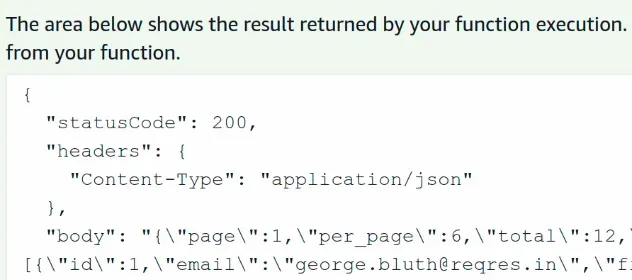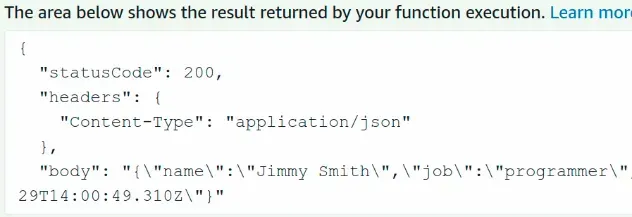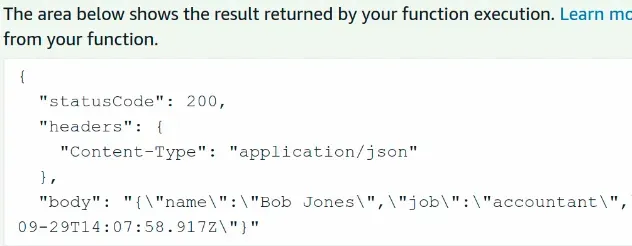Making Http Requests in a Node.js Lambda Function
Last updated: Feb 26, 2024
Reading time·6 min

# Table of Contents
- Make an Http GET Request in a Node.js Lambda
- Make an Http POST Request in a Node.js Lambda
- Make an Http PATCH Request in a Node.js Lambda
- Make an Http PUT Request in a Node.js Lambda
- Make an Http DELETE Request in a Node.js Lambda
# Make an HTTP GET Request in a Node.js Lambda
Let's look at an example HTTP GET request made in a Node.js Lambda function.
We'll use the native https node library so we don't have to add any dependencies.
I'll post the entire code snippet and then we'll go over the code.
const https = require('https'); function getRequest() { const url = 'https://reqres.in/api/users'; return new Promise((resolve, reject) => { const req = https.get(url, res => { let rawData = ''; res.on('data', chunk => { rawData += chunk; }); res.on('end', () => { try { resolve(JSON.parse(rawData)); } catch (err) { reject(new Error(err)); } }); }); req.on('error', err => { reject(new Error(err)); }); }); } exports.handler = async event => { try { const result = await getRequest(); console.log('result is: 👉️', result); // 👇️️ response structure assume you use proxy integration with API gateway return { statusCode: 200, headers: {'Content-Type': 'application/json'}, body: JSON.stringify(result), }; } catch (error) { console.log('Error is: 👉️', error); return { statusCode: 400, body: error.message, }; } };
The example uses the native https module, which is quite difficult to get
working with promises.
The getRequest function makes an HTTP GET request to fetch some data and
returns a Promise.
The Promise gets resolved on a successful request or rejected in case anything
went wrong.
In the handler function, we simply await the GET request in a try/catch
block and return a response.
Your Lambda function's response structure might vary. This example assumes that you're using an API Gateway with proxy integration.
Here's the output from testing the Lambda function in the console.

# Make an HTTP POST Request in a Node.js Lambda
Let's look at an example HTTP POST request made in a Node.js Lambda function.
The code uses the native https node library.
I'll post the entire code snippet and then we'll go over it.
const https = require('https'); function postRequest(body) { const options = { hostname: 'reqres.in', path: '/api/users', method: 'POST', port: 443, // 👈️ replace with 80 for HTTP requests headers: { 'Content-Type': 'application/json', }, }; return new Promise((resolve, reject) => { const req = https.request(options, res => { let rawData = ''; res.on('data', chunk => { rawData += chunk; }); res.on('end', () => { try { resolve(JSON.parse(rawData)); } catch (err) { reject(new Error(err)); } }); }); req.on('error', err => { reject(new Error(err)); }); // 👇️ write the body to the Request object req.write(JSON.stringify(body)); req.end(); }); } exports.handler = async event => { try { const result = await postRequest({ name: 'John Smith', job: 'manager', }); console.log('result is: 👉️', result); // 👇️️ response structure assumes you use proxy integration with API gateway return { statusCode: 200, headers: {'Content-Type': 'application/json'}, body: JSON.stringify(result), }; } catch (error) { console.log('Error is: 👉️', error); return { statusCode: 400, body: error.message, }; } };
The postRequest function takes the body for the request as an argument.
The options object has a port argument, which should be set to 443 for
HTTPS requests and 80 for HTTP requests.
The function returns a Promise. On a successful API response, the Promise
resolves with the data, otherwise, it rejects with an error.
A test invocation of the Lambda function shows that the POST request is
successful.

# Make an HTTP PATCH Request in a Node.js Lambda
Let's look at an example HTTP PATCH request made in a Node.js Lambda function.
I'll post the entire code snippet and then we'll go over the code.
const https = require('https'); function patchRequest(path, body) { const options = { hostname: 'reqres.in', // 👇 specify path e.g. /api/users/2 path: path, method: 'PATCH', port: 443, // 👈️ replace with 80 for HTTP requests headers: { 'Content-Type': 'application/json', }, }; return new Promise((resolve, reject) => { const req = https.request(options, res => { let rawData = ''; res.on('data', chunk => { rawData += chunk; }); res.on('end', () => { try { resolve(JSON.parse(rawData)); } catch (err) { reject(new Error(err)); } }); }); req.on('error', err => { reject(new Error(err)); }); // 👇️ write body on request object req.write(JSON.stringify(body)); req.end(); }); } exports.handler = async event => { try { const result = await patchRequest(`/api/users/2`, { name: 'Jimmy Smith', job: 'programmer', }); console.log('result is: 👉️', result); // 👇️️ response structure assume you use proxy integration with API gateway return { statusCode: 200, headers: {'Content-Type': 'application/json'}, body: JSON.stringify(result), }; } catch (error) { console.log('Error is: 👉️', error); return { statusCode: 400, body: error.message, }; } };
The PATCH request is similar to the POST request. This time, the
patchRequest function takes 2 parameters - the path and the body.
The path is the part after the hostname, e.g. - /api/users/2.
We set the method as PATCH in the options object.
Like in all other examples, the function returns a Promise and resolves it on
a successful API response or rejects it in case of an error.
A test invocation of the Lambda function shows that the PATCH request is
successful.

# Make an HTTP PUT Request in a Node.js Lambda
Let's look at an example HTTP PUT request made in a Node.js Lambda function.
We'll use the native https node library so we don't have to add any
dependencies.
PATCH and PUT examples is the value of the method property in the options object.I'll post the entire code snippet and then we'll go over the code.
const https = require('https'); function putRequest(path, body) { const options = { hostname: 'reqres.in', // 👇 specify path e.g. /api/users/2 path: path, method: 'PUT', port: 443, // 👈️ replace with 80 for HTTP requests headers: { 'Content-Type': 'application/json', }, }; return new Promise((resolve, reject) => { const req = https.request(options, res => { let rawData = ''; res.on('data', chunk => { rawData += chunk; }); res.on('end', () => { try { resolve(JSON.parse(rawData)); } catch (err) { reject(new Error(err)); } }); }); req.on('error', err => { reject(new Error(err)); }); // 👇️ write body on request object req.write(JSON.stringify(body)); req.end(); }); } exports.handler = async event => { try { const result = await putRequest(`/api/users/2`, { name: 'Bob Jones', job: 'accountant', }); console.log('result is: 👉️', result); // 👇️️ response structure assume you use proxy integration with API gateway return { statusCode: 200, headers: {'Content-Type': 'application/json'}, body: JSON.stringify(result), }; } catch (error) { console.log('Error is: 👉️', error); return { statusCode: 400, body: error.message, }; } };
The code for the PUT request is almost the same as the code for the PATCH
request. The only difference is the value of the method property in the
options object.
The path is the part after the hostname, e.g. - /api/users/2.
The putRequest function returns a Promise and resolves it on a successful
API response or rejects it in case of an error.
A test invocation of the Lambda function shows that the PUT request is
successful.

# Make an HTTP DELETE Request in a Node.js Lambda
Let's look at an example HTTP DELETE request made in a Node.js Lambda
function.
I'll post the entire code snippet and then we'll go over the code.
const https = require('https'); function deleteRequest(path) { const options = { hostname: 'reqres.in', // 👇 specify path e.g. /api/users/2 path: path, method: 'DELETE', port: 443, // 👈️ replace with 80 for HTTP requests headers: { 'Content-Type': 'application/json', }, }; return new Promise((resolve, reject) => { const req = https.request(options, res => { let rawData = ''; res.on('data', chunk => { rawData += chunk; }); res.on('end', () => { try { // 👇️ It's possible that your API has no response for DELETE requests // If so, remove `JSON.parse(rawData)` and simply resolve() resolve(JSON.parse(rawData)); } catch (err) { reject(new Error(err)); } }); }); req.on('error', err => { reject(new Error(err)); }); req.end(); }); } exports.handler = async event => { try { const result = await deleteRequest(`/api/users/2`); console.log('result is: 👉️', result); // 👇️️ response structure assume you use proxy integration with API gateway return { statusCode: 200, headers: {'Content-Type': 'application/json'}, body: JSON.stringify(result), }; } catch (error) { console.log('Error is: 👉️', error); return { statusCode: 400, body: error.message, }; } };
The deleteRequest function only takes the path as a parameter.
204 status on DELETE requests with no body. Other APIs send the deleted item in the response or a success message.The example HTTP request assumes that the API has a response value.
In the res.on('end') callback, we try to parse the response from the API. This
would fail if the API has no response value.
If that's the case with your API, simply resolve() instead of
resolve(JSON.parse(rawData)).
Your lambda function's response structure might vary. This example assumes that you're using an API Gateway with proxy integration.
# Additional Resources
You can learn more about the related topics by checking out the following tutorials:
- Create a Lambda Function with AWS CLI - Complete Guide
- Lambda Function Example in AWS CDK - Complete Guide
- Write TypeScript Lambda functions in AWS CDK - Complete Guide
- Configure Lambda Log Retention in AWS CDK
- Create Lambda Functions in a VPC in AWS CDK
- How to use Lambda Layers in AWS CDK - Complete Guide
- AWS CDK Tutorial for Beginners - Step-by-Step Guide
- How to use Parameters in AWS CDK
- How to convert an Object to FormData in JavaScript

